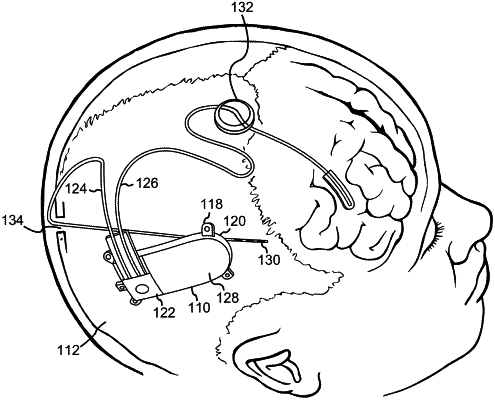| CPC A61B 5/374 (2021.01) [A61B 5/291 (2021.01); A61B 5/316 (2021.01); A61B 5/4094 (2013.01); A61B 5/686 (2013.01); A61B 5/6868 (2013.01); A61M 5/1723 (2013.01); A61N 1/36139 (2013.01); A61N 1/36171 (2013.01); A61N 1/37229 (2013.01); A61M 2210/0693 (2013.01); A61M 2230/10 (2013.01); A61N 1/0534 (2013.01); A61N 1/36064 (2013.01); A61N 1/36067 (2013.01)] | 4 Claims |

|
1. An implantable medical device comprising:
at least one sensor configured to be implanted in or on a brain of a patient, and to sense electrical activity of the brain; and
a processor coupled to the at least one sensor and configured to:
derive a phase-amplitude coupling index based on one or more measures of phase-amplitude coupling computed based on the sensed electrical activity;
evaluate the phase-amplitude coupling index relative to phase-amplitude coupling index criterion to determine if the patient is, or may soon be, in a state of abnormal neural activity; and
deliver a neuromodulation therapy to the patient if the patient is determined to be in a state of abnormal neural activity, by being further configured to:
stimulate a first area of the brain with a first stimulation waveform, where the first stimulation waveform comprises electrical stimulation pulses delivered at a low frequency within a low frequency range, and the processor stimulates the first area of the brain with the first stimulation waveform by being further configured to:
apply the sensed electrical activity of the brain to a low frequency range bandpass filter to obtain a low-frequency filtered brain signal, and
deliver the electrical stimulation pulses of the first stimulation waveform to the first area of the brain in synchrony or near-synchrony with fiducial points of the low-frequency filtered brain signal, and
stimulate a second area of the brain with a second stimulation waveform, where the second stimulation waveform comprises electrical stimulation pulses delivered at a high frequency greater than the low frequency, and the processor stimulates the second area of the brain with the second stimulation waveform by being further configured to:
apply the sensed electrical activity to a high frequency range bandpass filter to obtain a high-frequency filtered brain signal, and
deliver the electrical stimulation pulses of the second stimulation waveform to the second area of the brain in synchrony or near-synchrony with fiducial points of the high-frequency filtered brain signal.
|